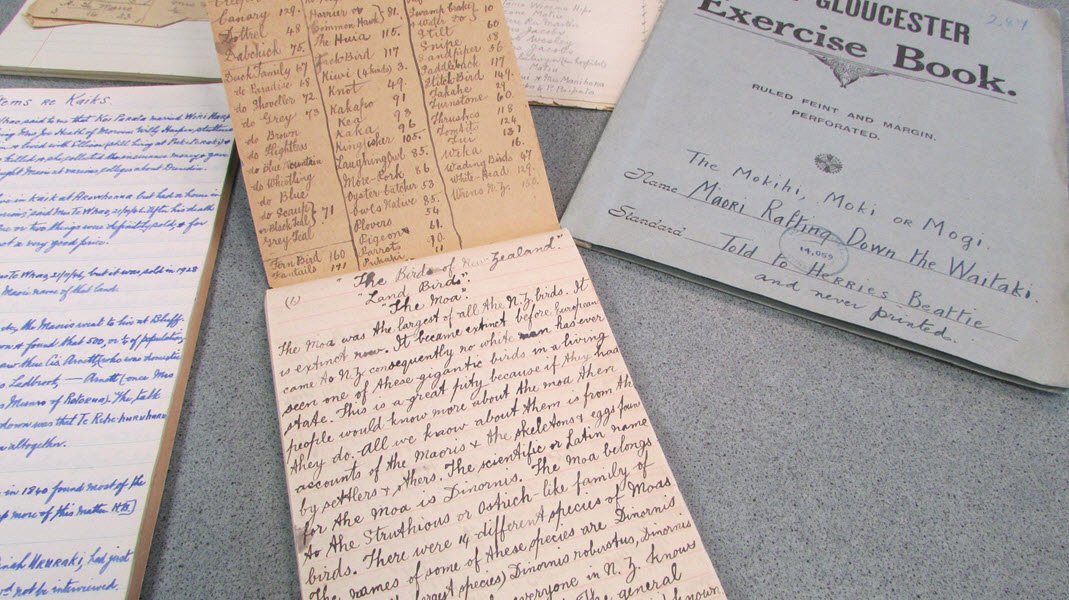
Hocken Collections in Ōtepoti Dunedin Māori Archivist Rauhina Scott-Fyfe (Kāi Tahu, Kāti Māmoe) spoke to about 50 people about Mr Beattie in Gore last week as part of Southland Heritage month.
Mr Beattie spent the first 30 years of his life in Gore.
Mx Scott-Fyfe is part of a team that is digitising the records Mr Beattie kept and that have been stored in the Hocken Library.
The title of their talk was Our Treasure Tō Tātou Taoka : Herries Beattie.
Mx Scott-Fyfe began by acknowledging there would be members of the audience who knew more about Mr Beattie than they did.
Nor did they speak from a historian’s perspective, they said.
"I speak from the perspective of getting to work with Herries Beattie’s taonga over the past year."
They knew Mr Beattie was well-remembered in Gore where he was born, and had heard about him since they were a child, Mx Scott-Fyfe said.
"From a young age I often heard his name being used in relation to Kāi Tahu history."
When they were at Otago University they came into contact with some of his writing at the Hocken Library when they were researching information for an assignment.
"I remembered being wowed by his handwriting, and that still hasn’t gone away," they said.
Mr Beattie was recording history at a time when his contemporaries were collecting items, they said.
"As a Pākehā New Zealander Beattie grew up in a colonial world which prized objects-focused collections, but he was able to recognise value in the history, tradition, life-ways and language of southern Māori which in those times ... few other Pākehā did."
Mx Fyfe-Scott gave some background to Mr Beattie’s life.
He was born in 1891 to Scottish immigrants James and Mary, and his father had a drapery business in Gore.
Mr Beattie became known as an amateur historian, ethnographer, author, record keeper and book store owner, they said.
"His curiosity for learning started at a very young age as a boy growing up in Gore."
His first book, written when he was 8 years old, was given to his parents and contained poetry, short stories and news articles.
Mr Beattie kept a diary from when he was 11, which is now part of the Hocken Collections.

At the start of his first diary, which he began in 1892, he wrote a short introduction about himself.
He noted that people who kept diaries should always tell the truth, and he would try to do that.
"I mean if possible to keep this book until I grow big as a remembrance of the days when I was a youth."
While he enjoyed school he did not excel, and failed an examination for free secondary schooling in 1894.
After two years at Southland Boys’ High School he left and worked in his father’s store, where he met his future wife Mary McKenzie.
"During this time Beattie continued to read, write and collect history, primarily relating to Gore," Mx Scott-Fyfe said.
In 1916 Mr Beattie was employed at Mataura Ensign (now The Ensign) as a reporter.
During that time he interviewed many early settlers.
It was interesting that the information Mr Beattie gathered - especially from women - was often about topics that would normally not be discussed, Mx Scott-Fyfe said.
"He was trusted and he was obviously well respected by those people that he put effort into building relationships with."
In 1920 he left Gore, following his family who had moved to Oamaru.
He was offered work at the University of Otago museum to travel the South Island collecting Māori lore and traditions.
He wrote the information in notebooks.
"I find it wonderful seeing the meticulous record keeping he kept.
"It involved 127 days of field work, 83 days of writing out notes, and those notes formed around 1000 pages."
He found that people did not talk so readily when he took notes, so he focused on listening and wrote the information down later, Mx Scott-Fyfe said.
He travelled by train but also by bicycle.
"He had [the bicycle] for over 60 years and he was still riding it on a daily basis in his 80s."
In 1922 he bought Manchester’s book shop and stationery in Waimate, and ran the business until 1939.

The entries often started with how he had taken a cold bath to start the day, which made an impression on Mx Scott-Fyfe.
"How very Scottish."
In his writing Mr Beattie came across as "being quite earnest".
"He had a strong Christian faith."
The Herries Beattie collection comprised 34 boxes of material including notebooks, letters, maps and speech notes.
"It’s more than 20,000 pages of written material."
There were 55 notebooks on different subjects and 34 notebooks focused on Māori history.
The collection also contained 27 newspaper clipping books, which he collected from a young age.
"This was how he built up his knowledge.
"We have the internet nowadays."
There was a note on the first album which recorded that the reason it looked tatty was because it had spent 24 hours under water during the 1913 Gore flood.
"He adds an extra note: ‘my house was on the Main St of Gore and was normally about three quarters of a mile from the Mataura River’."
In the 1916 flood, the water was inside the house, but his books and papers were out of reach.
In a 1957 essay on himself, Mr Beattie said his record-keeping reflected a "lifelong passion to know everything I could about everything that interested me and also my tenacity of purpose in preserving the minutest detail of my studies."
He died in 1972, aged 90.
Having the collection digitised would make it more accessible, Mx Scott-Fyfe said.
It was planned the material would become publicly available on June 6.
"It is Beattie’s birthday."












